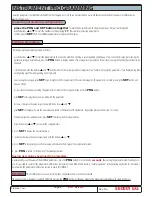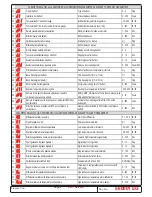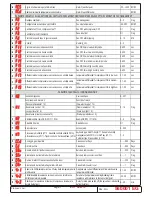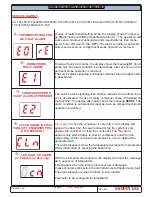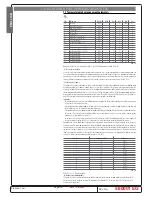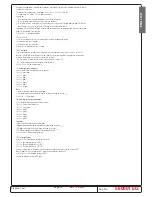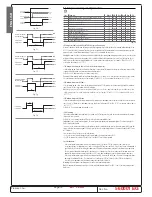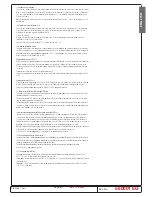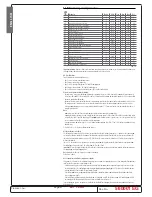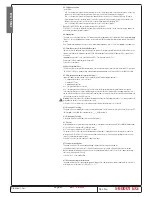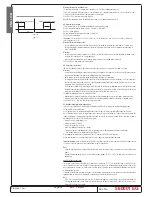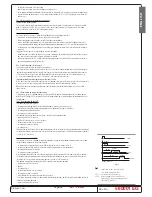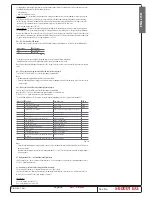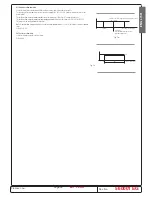
Doc. No.:
560001 EG
Page:15
Ed.1" 08-2014
From ser. no.:
ENGLISH
7.1 Temperature probe management parameters
Code
Parameter
Models
UOM
Type
Min
Max
Def.
Pw
Password MSYF
-
C
0
200
22
/2
Measurement stability
MSYF
-
C
1
15
4
/3
Probe display response
MSYF
-
C
0
15
0
/4
Virtual probe
MSYF
-
C
0
100
0
/5
Select °C or °F
MSYF
fl ag
C
0
1
0
/6
Decimal point
MSYF
fl ag
C
0
1
0
/tI
Display on internal terminal
MSYF
-
C
1
7
1
/tE
Display on external terminal
MSYF
-
C
0
6
0
/P
Select type of probe
MSYF
-
C
0
2
0
/A2
Confi guration of probe 2 (S2)
YF
-
C
0
4
2
MS
-
C
0
4
0
/A3
Confi guration of probe 3 (S3, DI 1)
MSYF
-
C
0
4
0
/A4
Confi guration of probe 4 (S4, DI 2)
MSYF
-
C
0
4
0
/A5
Confi guration of probe 5 (S5, DI 3)
MSYF
-
C
0
4
0
/c1
Calibration of probe 1
MSYF
°C/°F
C
-20
20
0.0
/c2
Calibration of probe 2
MSYF
°C/°F
C
-20
20
0.0
/c3
Calibration of probe 3
MSYF
°C/°F
C
-20
20
0.0
/c4
Calibration of probe 4
MSYF
°C/°F
C
-20
20
0.0
/c5
Calibration of probe 5
MSYF
°C/°F
C
-20
20
0.0
Tab. 7.a
Note:
par. /A5 and /c5 refer to instruments with 5 relays (ir33DIN, powercompact and MasterCella).
‘/2’: Measurement stability
Defi nes the coeffi cient used to stabilise the temperature reading. Low values assigned to this parameter allow a prompt response of
the sensor to temperature variations, but the reading becomes more sensitive to disturbance. High values slow down the response, but
guarantee greater immunity to disturbance, that is, a more stable and more precise reading. The parameter acts on the temperature
readings, fi ltering the minimum variations, and at the same time considers the average of the readings. Default: ‘/2’=4.
/3: Probe display response
This parameter is used to set the update rate for the temperature display. The temperature shown on the display tends to follow rapid
deviations away from the set point very slowly, and vice-versa, moves very quickly in the event where the temperature displayed is
nearing the set point. If the control temperature exceeds the high or low temperature thresholds (and an AL or AH alarm is activated), or
if the maximum number of fi ltering steps (255) is exceeded (see the Timeout column in Table 7.b), the fi ltering would immediately be
bypassed and the temperature displayed would be the temperature eff ectively measured, until all the alarms are reset. The parameter
only aff ects the temperature displayed, and not the temperature used for the control functions.
Important:
• the control temperature actually measured diff ers from the value displayed, and therefore the outputs may not be activated with
reference to the latter temperature value.
• if the probe displayed is a product probe, with temperature values higher than the set point, the probe display rate algorithm will
be faster for decreases in the temperature and slower for increases;
• if the probe displayed is an evaporator or condenser probe, the display rate algorithm always refers to the set point and thus may
have specifi c eff ects (fast when the evap. probe reading increases and slow when it decreases; fast when the condenser probe
reading decreases and slow when it increases);
• the parameter /3 acts on the temperature displayed by the instrument, if /tE=0 (no probe displayed by the repeater display); if
the repeater display is confi gured (/tE <> 0), the parameter /3 will act on the temperature displayed by the repeater.
Example:
in the case of “bottle coolers”, typically used in supermarkets, when the doors are opened frequently, due to the greater
thermal inertia of the liquids compared to the air (and the fact that the probe is positioned in the air and not directly on the products),
the instrument measures a temperature that is higher than eff ective temperature of the soft drinks, thus displaying a quite “unrealistic”
temperature. Setting the parameter /3 to a value other than 0, any abrupt variations in temperature are “fi ltered” on the display,
showing a temperature trend that is “closer” to the actual trend of the product temperature. The following table shows the possible
values of ‘/3’ and the corresponding display delayed update values (Tdel).
Value of par. /3
Display delay (Tdel)
Timeout
0
Disabled
0
1
5 s
21 min
2
10 s
42 min
3
15 s
64 min
4
20 s
85 min
5
25 s
106 min
6
30 s
127 min
7
40 s
170 min
8
50 s
212 min
9
60 s
255 min
10
75 s
319 min
11
90 s
382 min
12
105 s
446 min
13
120 s
510 min
14
150 s
637 min
15
180 s
765 min
Tab. 7.b
Default: ‘/3’=0 => Function disabled.
/4: Probe average (virtual probe)
This parameter is used to choose whether to control the temperature based solely on the room probe reading, or alternatively
whether to refer to the “weighted” average of the room probe S1 and probe 2 (S2, see the parameter ‘/A2’). This parameter is
useful in special applications.
7. DESCRIPTION OF THE OPERATING PARAMETERS




